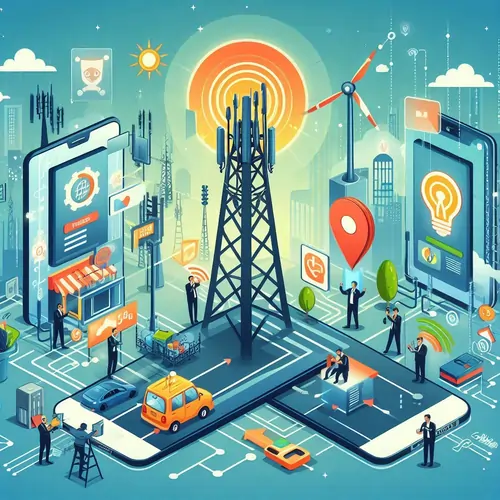- The Growing Importance of Energy Efficiency in Networks
- Spectrum Usage in Modern Cellular Networks
- Strategic Band Management: Reducing Energy Usage at Low Traffic Times
- Real-World Application of Band Switching
- Extending the Concept to Enterprise Wi-Fi Networks
- Key Considerations for Implementing Energy-Saving Strategies
- Broader Impact of Energy Efficiency in Networks
- Future Directions for Energy-Efficient Networks
- How Students Can Benefit from Understanding This Topic
- Conclusion
In today’s digital era, mobile and cellular networks form the backbone of global connectivity, enabling everything from high-definition video streaming on smartphones to mission-critical enterprise operations. These networks handle massive volumes of data every second, ensuring seamless communication across urban, suburban, and rural regions. However, this uninterrupted service comes with a significant challenge—high energy consumption. Network operators must balance growing data traffic with sustainable energy use while maintaining coverage and performance. At computernetworkassignmenthelp.com, our team focuses on analyzing emerging technological trends and practical solutions that shape the future of networking. One of the most critical areas involves developing strategies to reduce energy usage without compromising user experience. Modern cellular systems rely on multiple spectrum bands, which can be intelligently managed to match real-time demand. For example, selectively disabling high-frequency bands during periods of low traffic, such as at night, allows operators to save substantial energy while continuing to provide reliable service through low-frequency bands. These innovations not only reduce operational costs but also support environmental sustainability goals. As the industry evolves, understanding these techniques becomes essential, and our computer network assignment help experts assist students in mastering the technical and practical aspects of energy-efficient networking.
The Growing Importance of Energy Efficiency in Networks

Energy consumption has become a critical factor for both economic and environmental reasons. Network operators run vast infrastructures comprising base stations, antennas, servers, routers, and transmission equipment. These components are operational 24/7 to ensure uninterrupted connectivity, which leads to significant power usage.
Interestingly, studies show that the total energy consumption of telecommunications networks tends to remain constant over time, even as the number of subscribers increases and data traffic grows at an even higher rate. This may seem counterintuitive—more users and more data should logically require more energy. However, technological advancements, better hardware efficiency, and smarter network management techniques help operators balance energy use despite traffic growth.
Yet, this balance is not automatic. Operators continuously seek ways to minimize energy consumption further. Reducing power usage not only cuts operational costs but also supports global sustainability goals and reduces carbon footprints.
Spectrum Usage in Modern Cellular Networks
Modern mobile networks rely on multiple spectrum bands to deliver reliable connectivity. Different frequency bands have different characteristics:
- Low-frequency bands (e.g., below 1 GHz) provide wide coverage and good penetration through walls and other obstacles. However, their capacity is relatively limited, meaning they can handle fewer simultaneous users and less data per second.
- High-frequency bands (e.g., several GHz and above) offer much higher capacity, enabling fast data rates and serving dense urban areas efficiently. However, their coverage range is shorter, and signals can be more easily obstructed by buildings and terrain.
Today’s smartphones and network infrastructure are designed to dynamically switch between these bands, depending on network conditions and availability. This flexibility ensures users receive the best possible service whether they are in crowded city centers, suburban neighborhoods, or rural areas.
This multi-band capability plays a crucial role in optimizing both network performance and energy efficiency. By intelligently selecting which bands to activate and when, operators can fine-tune their network to match real-time demand.
Strategic Band Management: Reducing Energy Usage at Low Traffic Times
One of the most effective ways to save energy in cellular networks is to adjust spectrum usage during periods of low traffic. Consider the typical daily pattern of mobile network usage:
- Daytime often sees peak traffic, especially during working hours and evening streaming times.
- Nighttime generally experiences a significant drop in user activity, as fewer people use mobile data while they sleep.
During these low-traffic hours, keeping all high-capacity, high-frequency bands active is often unnecessary. Instead, operators can temporarily switch off certain high-frequency bands, relying primarily on low-frequency bands to provide coverage for the smaller number of users online.
This approach offers two major benefits:
- Energy Savings: High-frequency equipment typically consumes more power because it needs to support higher data rates and more complex signal processing. Turning it off during quiet periods can lead to considerable energy reductions.
- Maintained User Experience: Because low-frequency bands provide adequate coverage, users who remain connected at night experience little to no difference in service quality. The network is simply scaled down to match demand.
This adaptive network operation demonstrates how intelligent management of existing infrastructure can yield immediate and measurable energy efficiency gains without requiring new technology or hardware.
Real-World Application of Band Switching
Many network operators have recognized the potential of dynamic band management and have implemented strategies to optimize energy usage. By analyzing traffic patterns, operators can identify time windows—often at night—when certain bands can be safely switched off.
For example, in scenarios where high-frequency bands are disabled during the night, network monitoring shows that user experience remains consistent. This is because the low-frequency bands alone are sufficient to handle the reduced traffic. Such strategies can also be applied beyond nighttime if certain regions experience predictable dips in usage during other parts of the day, such as weekends or holidays.
This technique reflects a broader shift in network management philosophy: instead of running the network at full capacity at all times, operators are moving toward context-aware, demand-driven operation. This not only saves energy but also extends the lifespan of equipment and reduces maintenance costs.
Extending the Concept to Enterprise Wi-Fi Networks
While these strategies are commonly associated with large-scale cellular networks, enterprise Wi-Fi networks can apply similar principles. Many organizations operate extensive Wi-Fi infrastructures to provide connectivity across offices, campuses, or industrial sites. Typically, these networks use multiple frequency bands (such as 2.4 GHz and 5 GHz) to deliver coverage and capacity.
However, during non-operational hours—such as nights, weekends, or holidays—many enterprise sites have minimal or no network usage. In such cases, not all frequency bands need to remain active. By selectively disabling some access points or high-frequency bands during these times, enterprises can achieve significant energy savings without compromising the user experience during business hours.
For instance, an office building may turn off the 5 GHz band after working hours while keeping minimal 2.4 GHz coverage for essential devices such as security systems. This targeted reduction lowers power consumption and contributes to sustainability goals.
Key Considerations for Implementing Energy-Saving Strategies
While the potential benefits are clear, implementing energy-saving strategies in cellular and enterprise networks requires careful planning and management. Some of the key considerations include:
- Traffic Pattern Analysis
- Automation and Control Systems
- Monitoring and Feedback
- Regulatory and Coverage Requirements
Before switching off frequency bands, operators must conduct a thorough analysis of traffic patterns to identify when and where energy-saving measures can be applied without disrupting service. This involves collecting data over time and using predictive models to anticipate demand.
Manual intervention for turning bands on and off is impractical. Instead, automated network management systems are used to dynamically adjust configurations based on real-time traffic conditions. This ensures a smooth transition without manual oversight.
Once energy-saving measures are implemented, continuous monitoring is essential to ensure service quality is maintained. Feedback loops help operators fine-tune parameters and respond quickly if unexpected issues arise.
In some regions, regulatory frameworks may specify minimum coverage levels or service quality standards. Operators must ensure that energy-saving measures do not violate these obligations.
Broader Impact of Energy Efficiency in Networks
Improving energy efficiency in cellular networks has implications that go far beyond reducing electricity bills. Some of the broader impacts include:
- Environmental Benefits: Lower energy consumption means reduced greenhouse gas emissions, supporting global sustainability and climate goals.
- Operational Cost Reduction: Energy is a major expense for network operators. Efficient energy use directly improves profitability and financial stability.
- Enhanced Network Resilience: Networks that can intelligently scale resources based on demand are often more resilient during unexpected events, such as power outages or emergencies.
- Extended Equipment Lifespan: Reducing operational intensity during low-demand periods can decrease wear and tear on equipment, lowering replacement and maintenance costs.
Future Directions for Energy-Efficient Networks
As technology continues to evolve, the scope for energy savings in cellular networks will expand even further. Several promising directions are already emerging:
- AI-Driven Network Optimization
- Advanced Sleep Modes for Equipment
- Integration with Renewable Energy
- Edge Computing and Distributed Architectures
Artificial intelligence can play a key role in predicting traffic patterns, controlling spectrum usage, and making real-time decisions to minimize energy consumption while maintaining performance.
Future base stations and network devices may include more sophisticated sleep and wake mechanisms, allowing them to rapidly power down or enter low-energy states when idle, then quickly resume full operation when needed.
Some operators are exploring ways to power network equipment using renewable energy sources, such as solar or wind, to further reduce environmental impact.
By processing data closer to the user at the network edge, operators can reduce the load on centralized data centers, leading to more balanced energy usage across the network.
How Students Can Benefit from Understanding This Topic
For students studying computer networks, understanding the energy dimension of network operations is becoming increasingly important. Network design is no longer just about throughput, latency, and coverage—it also involves sustainability and efficiency.
When working on assignments or real-world projects, students who grasp concepts like spectrum management, dynamic resource allocation, and energy-aware design will be well-equipped to tackle modern networking challenges. These skills are valuable in both academic contexts and professional roles within telecom operators, enterprises, and technology companies.
At computernetworkassignmenthelp.com, our team frequently assists students with assignments, projects, and case studies related to these evolving areas of network technology. We aim to make complex concepts accessible, helping learners build a strong foundation that bridges theory and practice.
Conclusion
Energy consumption in cellular networks is more than just a technical issue—it’s a strategic challenge with economic, environmental, and operational dimensions. By understanding traffic patterns and strategically managing frequency bands, network operators can significantly reduce energy usage without compromising user experience.
These principles are not limited to large telecom infrastructures; enterprise networks can adopt similar strategies to reduce costs and contribute to sustainability. As networks continue to evolve, energy efficiency will remain a central focus, shaping how networks are designed, deployed, and managed.
For students, this represents an exciting opportunity to engage with cutting-edge developments in networking. At computernetworkassignmenthelp.com, we provide expert guidance to help students navigate these complex topics with confidence and clarity.
